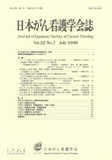Japanese
English
- 販売していません
- Abstract 文献概要
- 参考文献 Reference
要旨
<背景>がん診療連携拠点病院の増加に伴い,緩和ケアチーム(PCT)が急増しているが,PCTが具体的にどのような支援をするのかは明らかでない.
<目的>これまで先駆的な活動をしてきた一大学病院で活動するPCTの支援内容を,参加観察法を用いて明らかにする.
<方法>2004年2〜10月,緩和ケア診療加算算定以前から活動を行う一大学病院のPCTメンバー3名を対象とし参加観察を行った.観察場面は特定せず,PCTメンバーと病棟スタッフや患者・家族,その他の職種との相互作用の過程でとった言動を観察した.観察した事柄についてフィールドノーツを作成し,内容分析の手法を参考として分析を行った.
<結果>PCTの支援内容は,82のサブカテゴリから成る7つのカテゴリに整理された.すなわち,【症状緩和】【患者の精神的サポート】【治療目標の明確化】【療養場所の選択・移行のサポート】【看取りが近い患者のサポート】【家族のケア】【医療者への教育・サポート】であった.加えて,PCTがよりよく機能するための基盤作りについて,6つのサブカテゴリから成る1つのカテゴリが得られた.
<結論>先駆的な活動をしてきたPCTが実際に提供している支援内容が明らかとなった.これは,PCTの具体的な活動指針になる点で非常に有用と考えられる.
Abstract
Background : As the number of regional cancer centers increases, the number of hospitalbased palliative care teams is also increasing rapidly. However, it is not clear what kind of support palliative care teams provide.
Purpose : To illustrate what kind of support a pioneering palliative care team provides, using a participant-observation approach.
Methods : From February to October 2004, we collected data using a participant-observation approach with three members of a palliative care team in a university hospital, which has operated since before palliative care team services were covered by National Health Insurance. Words and actions involved in the interaction between palliative care team members and ward staff/patients/families/other professional care-givers were recorded as field notes. Data were analyzed using a content analysis method.
Results : Contents of support provided by a palliative care team was divided into seven categories, with 82 sub-categories. The categories are symptom management, emotional support for patients, clarifying care goals, support for selection of and transfer to place of care, terminal care, family support, education and emotional support for professional care-givers. Strategies for better palliative care team function, comprising 6 sub-categories were also formulated.
Conclusion : We elucidated the contents of support provided by a pioneering palliative care team in Japan. Our findings should be a helpful reference as a practical guideline for newer palliative care teams.
Copyright © 2008, Japanese Society of Cancer Nursing All rights reserved.


